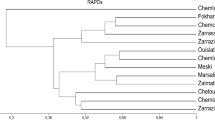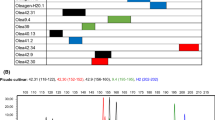Abstract
Olea europaea L. is one of the most economically important crops in the Mediterranean area, and known for having large genetic variability. In order to assess the genetic diversity, DNA from 41 olive cultivars, present in the protected denomination of origin (PDO) region of Trás-os-Montes, was screened using inter simple sequence repeat (ISSR) and microsatellite (SSR) markers. Eleven ISSR primers amplified 135 reproducible bands of which 108 were polymorphic. The percentage of polymorphic bands detected by ISSR was 79%. The highest number of polymorphic bands was obtained by the use of primers UBC807 (15) and UBC809 (16). A total of 67 alleles were detected by six SSR primers, with an average of 11 alleles per primer. The number of alleles per locus ranged from five (ssrOeUaDCA05) to 15 (ssrOeUaDCA03). The observed heterozygosity ranged from 0.219 (ssrOeUaDCA05) to 0.900 (ssrOeUaDCA04), while the expected heterozygosity varied between 0.426 (ssrOeUaDCA05) and 0.887 (ssrOeUaDCA03). The polymorphism information content (PIC) values ranged from 0.392 (ssrOeUaDCA05) to 0.863 (ssrOeUaDCA03). The collection of primers selected gave a reasonable number of amplification products for the genetic diversity analysis. Based on the results, the genetic diversity among 41 olive cultivars is discussed. This study reveals the great importance of guaranteeing the differentiation of olive cultivars and their application for certification purposes.




Similar content being viewed by others
References
Bandelj D, Jakse J, Javornik B (2004) Assessment of genetic variability of olive varieties by microsatellite and AFLP markers. Euphytica 136:93–102. doi:10.1023/B:EUPH.0000019552.42066.10
Belaj A, Satovic Z, Rallo L, Trujillo I (2002) Genetic diversity and relationships in olive (Olea europaea L.) germplasm collections as determined by randomly amplified polymorphic DNA. Theor Appl Genet 105:638–644
Belaj A, Caballero JM, Barranco D, Rallo L, Trujillo I (2003) Genetic characterization and identification of new accessions from Syria in an olive germplasm bank by means of RAPD markers. Euphytica 134:261–268. doi:10.1023/B:EUPH.0000004954.93250.f5
Belaj A, Muñoz-Diez C, Baldoni L, Porceddu A, Barranco D, Satovic Z (2007) Genetic diversity and population structure of wild olives from the North-western Mediterranean assessed by SSR markers. Ann Bot (Lond) 100(3):449–458. doi:10.1093/aob/mcm132
Besnard G, Baradat P, Berville A (2001) Genetic relationship in the olive (Olea europaea L.) reflect multilocal selection of cultivars. Theor Appl Genet 102:251–258. doi:10.1007/s001220051642
Botstein D, White RL, Skolnick M, Davis RW (1980) Construction of a genetic linkage map in man using restriction fragment length polymorphisms. Am J Hum Genet 32(3):314–331
Cipriani G, Marrazzo MT, Marconi R, Cimato A, Testolin R (2002) Microsatellite markers isolated in olive are suitable for individual fingerprinting and reveal polymorphism within ancient cultivars (Olea europaea L.). Theor Appl Genet 104:223–228. doi:10.1007/s001220100685
Consolandi C, Palmieri L, Doveri S, Maestri E, Marmiroli N, Reale S, Lee D, Baldoni L, Tosti N, Severgnini M, Bellis G, Castiglioni B (2007) Olive variety identification by ligation detection reaction in a universal array format. J Biotechnol 129(3):565–574. doi:10.1016/j.jbiotec.2007.01.025
Contento A, Ceccarelli M, Gelati MT (2002) Diversity of Olea genotypes and the origin of cultivated olives. Theor Appl Genet 104:1229–1238. doi:10.1007/s00122-001-0799-7
Díaz R, De la Rosa R, Martín A, Rallo P (2006) Development, characterization and inheritance of new microsatellites in olive (Olea europaea L.) and evaluation of their usefulness in cultivar identification and genetic relationship studies. Tree Genet Genomes 2:165–175. doi:10.1007/s11295-006-0041-5
Fabbri A, Hormaza JI, Polito VS (1995) Random amplified polymorphic DNA analysis of olive (Olea europaea L.) cultivars. J Am Soc Hortic Sci 120:538–542
Ganino T, Beghè D, Valenti S, Nisi R, Fabbri A (2007) RAPD and SSR markers for characterization and identification of ancient cultivars of Olea europaea L. in the Emilia region, Northern Italy. Genet Resour Crop Evol 54(7):1531–1540. doi:10.1007/s10722-006-9145-x
Gemas VJV, Almadanim MC, Tenreiro R, Martins A, Fevereiro P (2004) Genetic diversity in the olive tree (Olea europaea L. subsp. europaea) cultivated in Portugal revealed by RAPD and ISSR markers. Genet Resour Crop Evol 51:501–511. doi:10.1023/B:GRES.0000024152.16021.40
Gomes S, Martins-Lopes P, Lima-Brito J, Meirinhos J, Lopes J, Martins A, Guedes-Pinto H (2008) Evidence of clonal variation in olive ‘Verdeal-Transmontana’ cultivar using RAPD, ISSR and SSR markers. J Hortic Sci Biotechnol 83(4):395–400
Hess J, Kadereit W, Vargas P (2000) The colonization history of Olea europaea L. in Macaronesia based on internal transcribed spacer 1 (ITS-1) sequences, randomly amplified polymorphic DNAs (RAPD), and intersimple sequence repeats (ISSR). Mol Ecol 9:857–868. doi:10.1046/j.1365-294x.2000.00942.x
Leitão F, Potes MF, Calado ML, Almeida FJ (1986) Descrição de 22 variedades de oliveira cultivadas em Portugal. Ministério da agricultura, pescas e alimentação 1–111
Lopes SM, Mendonça D, Sefc KM, Sabino Gil F, Câmara Machado A (2004) Genetic evidence of intra-cultivar variability within Iberian olive cultivars. Hortic Sci 39(7):1562–1565
Martins-Lopes P, Lima-Brito J, Gomes S, Meirinhos J, Santos L, Guedes-Pinto H (2007) RAPD and ISSR molecular markers in Olea europaea L.: genetic variability and cultivar identification. Genet Resour Crop Evol 54:117–128. doi:10.1007/s10722-005-2640-7
Mekuria GT, Collins GG, Sedgley M (1999) Genetic variability between different accessions of some common commercial olive cultivars. J Hortic Sci Biotechnol 74:309–314
Minch E, Ruiz-Linares A, Goldstein D, Feldman M, Kidd JR, Cavalli-Sforza LL (1997) Microsat 1.5: a computer program for calculating statistics on microsatellite data. Washington State University, Pullman
Nei M (1987) Molecular evolutionary genetics. Columbia University Press, New York
Omrani-Sabbaghi A, Shahriari M, Falahati-Anbaran M, Mohammadi SA, Nankali A, Mardi M, Ghareyazie B (2007) Microsatellite markers based assessment of genetic diversity in Iranian olive (Olea europaea L.) collections. Sci Hortic (Amsterdam) 112(4):439–447. doi:10.1016/j.scienta.2006.12.051
Pasqualone A, Caponio F, Blanco A (2001) Inter-simple sequence repeats DNA markers for identification of drupes from different Olea europaea L. cultivars. Eur Food Res Technol 213:240–243. doi:10.1007/s002170100367
Rallo P, Dorado G, Martin A (2000) Development of simple sequence repeats (SSRs) in olive tree (Olea europaea L.). Theor Appl Genet 101:984–989. doi:10.1007/s001220051571
Rallo P, Dorado G, Martin A (2002) Application of microsatellite markers in olive breeding. Proc. 4th IS on Olive Growing. Acta Hortic 586:69–71
Rohlf M (1998) NTSYS-pc. Numerical taxonomy and multivariate analysis system, version 2.02i. Department of Ecology and Evolution. State University of New York, Setauket, NY
Sefc KM, Lopes MS, Mendonça D, Rodrigues Dos Santos M, Da Câmara Machado ML, Da Câmara Machado A (2000) Identification of microsatellite loci in olive (Olea europaea) and their characterization in Italian and Iberian olive trees. Mol Ecol 9:1171–1173. doi:10.1046/j.1365-294x.2000.00954.x
Sensi E, Vignani R, Scali M, Masi E, Cresti M (2003) DNA fingerprinting and genetic relatedness among cultivated varieties of Olea europaea L. estimated by AFLP analysis. Sci Hortic (Amsterdam) 97:378–388. doi:10.1016/S0304-4238(02)00163-2
Tautz D, Trick M, Dover GA (1986) Cryptic simplicity in DNA is a major source of genetic variation. Nature 322:652–656. doi:10.1038/322652a0
Zane L, Bargelloni L, Patarnello T (2002) Strategies for microsatellite isolation: a review. Mol Ecol 11:1–16. doi:10.1046/j.0962-1083.2001.01418.x
Zietkiewicz E, Rafalski A, Labuda D (1994) Genome fingerprinting by simple sequence repeat (SSR)-anchored polymerase chain reaction amplification. Genomics 20:176–178. doi:10.1006/geno.1994.1151
Acknowledgements
This work was supported by IBB/CGB-UTAD and by the Ph.D. grant to Sónia Gomes (SFRH/BD/25384/2005), from the Portuguese Foundation for Science and Technology (FCT).
Author information
Authors and Affiliations
Corresponding author
Rights and permissions
About this article
Cite this article
Gomes, S., Martins-Lopes, P., Lopes, J. et al. Assessing Genetic Diversity in Olea europaea L. Using ISSR and SSR Markers. Plant Mol Biol Rep 27, 365–373 (2009). https://doi.org/10.1007/s11105-009-0106-3
Published:
Issue Date:
DOI: https://doi.org/10.1007/s11105-009-0106-3




